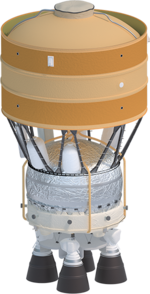Exploration Upper Stage
 2020 Design of the Exploration Upper Stage | |
| Manufacturer | Boeing[1] |
|---|---|
| Country of origin | Vereinigte Staaten |
| Used on | SLS Block 1B[2] |
| General characteristics | |
| Height | not to exceed 18 m (59 ft) |
| Diameter | 8.4 m (28 ft) |
| Propellant mass | up to 129,000 kg (284,000 lb) |
| Engine details | |
| Powered by | 4 RL10-C3[3][4] |
| Maximum thrust | 433.1 kN (97,360 lbf) |
| Propellant | LOX / LH2 |
The Exploration Upper Stage (EUS) is being developed as a large second stage for Block 1B of the Space Launch System (SLS), succeeding Block 1's Interim Cryogenic Propulsion Stage. It will be powered by four RL10-C3[4] engines burning liquid oxygen and liquid hydrogen to produce a total thrust of 433.1 kN (97,360 lbf). As of February 2015[update], the SLS Block 1B will have a payload capacity, to low Earth orbit, of 105 t (103 long tons; 116 short tons).[5] The EUS is expected to first fly on Artemis IV in March 2026.[6]
Development
The Block 1 configuration of SLS will have a core stage powered by four RS-25 engines, two Space Shuttle-derived five-segment solid rocket boosters, and an Interim Cryogenic Propulsion Stage (ICPS) upper stage.[7][8]
NASA will develop the EUS to increase SLS performance beyond Block 1 specifications. The improved upper stage was originally named the Dual Use Upper Stage (DUUS, pronounced "duce")[9] but was later renamed the Exploration Upper Stage (EUS) due to DUUS sounding like a profanity in Japanese.[10]
In 2014, NASA announced that it would proceed with development of Block 1B with the EUS[11] and would use it on EM-2.[2] In April 2016, it was reported that NASA has chosen to use a design based on four RL10-C3 engines for the EUS,[3] and in October 2016 NASA confirmed they had ordered 10 of the engines.[4]
In 2018, it was decided to optimise EUS for payload to lunar missions, by using smaller tanks.[12]
By February 2020, the development contract for EUS had been delayed, and NASA was planning to use ICPS for the first three launches of SLS.[13]
Boeing announced on 21 December 2020 that the Exploration Upper Stage (EUS) of the SLS completed a critical design review (CDR) with NASA. That review confirmed the design of the EUS, allowing Boeing to proceed with development of the stage, including hardware fabrication.[14]
Cost concerns and alternatives
Due to the possible cost of EUS (about US$800 million each), NASA invited proposals for alternatives, but in May 2019 rejected Blue Origin's proposal.[15] NASA ordered eight EUSs from Boeing.[15]
See also
References
- ^ "NASA, Boeing Finalize US$2.8 billion SLS Core Stage Contract". SpaceNews. 4 July 2014. Archived from the original on 27 July 2014. Retrieved 25 July 2014.
- ^ a b "NASA confirms EUS for SLS Block IB design and EM-2 flight". NASASpaceflight.com. 6 June 2014. Retrieved 25 July 2014.
- ^ a b Bergin, Chris (7 April 2016). "MSFC propose Aerojet Rocketdyne supply EUS engines". NASASpaceflight.com. Retrieved 8 April 2016.
- ^ a b c Proven Engine Packs Big, In-Space Punch for NASA's SLS Rocket. October 2016
 This article incorporates text from this source, which is in the public domain.
This article incorporates text from this source, which is in the public domain.
- ^ "Advanced Boosters progress towards a solid future for SLS". NASASpaceFlight.com. 20 February 2015. Retrieved 12 March 2015.
- ^ Sloss, Philip (17 February 2021). "NASA completes Exploration Upper Stage CDR, focuses new office on SLS Block 1B development". NASASpaceFlight.com. Retrieved 17 November 2021.
The recent GAO-21-105 audit noted that the Artemis 4 mission that would debut Block 1B and EUS is forecast to launch in March 2026.
- ^ "SLS". Gunter's Space Page. Retrieved 25 July 2014.
- ^ "Space Launch System Data Sheet". SpaceLaunchReport.com. Retrieved 25 July 2014.
- ^ "SLS prepares for PDR – Evolution eyes Dual-Use Upper Stage". NASASpaceflight.com. June 2013. Retrieved 25 July 2014.
- ^ Bergin, Chris (28 March 2014). "SLS positioning for ARRM and Europa missions". NASASpaceflight.com. Retrieved 8 November 2014.
- ^ Bergin, Chris (30 July 2012). "Wind Tunnel testing conducted on SLS configurations, including Block 1B". NASASpaceFlight.com. Retrieved 12 March 2015.
- ^ NASA completes Exploration Upper Stage CDR, focuses new office on SLS Block 1B development. Feb 2021.
- ^ Upper Stage RL10s arrive at Stennis for upcoming SLS launches. February 2020.
- ^ "SLS Exploration Upper Stage passes review". SpaceNews. 22 December 2020. Retrieved 22 December 2020.
- ^ a b NASA rejects Blue Origin's offer of a cheaper upper stage for the SLS rocket May 2019
